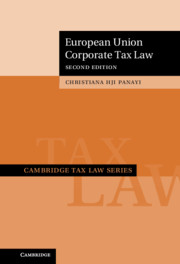Book contents
- Frontmatter
- Dedication
- Contents
- Foreword to the First Edition by Malcolm Gammie QC
- Foreword to the First Edition by Michael Lang
- Foreword to the Second Edition by Philip Baker
- Preface to the First Edition
- Preface to the Second Edition
- 1 A Historical Trajectory of EU Corporate Tax Law
- 2 EU Corporate Tax Legislation
- 3 The Court of Justice and the Development of EU Corporate Tax Law
- 4 Tax Obstacles to the Cross-Border Movement of Companies: Direct Investment
- 5 Tax Obstacles to Cross-Border Portfolio Investment
- 6 Reorganisations under EU Tax Law
- 7 Tax Avoidance and EU Law
- 8 State Aid and Taxation
- 9 EU Corporate Tax Law: More Interim Conclusions and Thoughts
6 - Reorganisations under EU Tax Law
Published online by Cambridge University Press: 28 May 2021
- Frontmatter
- Dedication
- Contents
- Foreword to the First Edition by Malcolm Gammie QC
- Foreword to the First Edition by Michael Lang
- Foreword to the Second Edition by Philip Baker
- Preface to the First Edition
- Preface to the Second Edition
- 1 A Historical Trajectory of EU Corporate Tax Law
- 2 EU Corporate Tax Legislation
- 3 The Court of Justice and the Development of EU Corporate Tax Law
- 4 Tax Obstacles to the Cross-Border Movement of Companies: Direct Investment
- 5 Tax Obstacles to Cross-Border Portfolio Investment
- 6 Reorganisations under EU Tax Law
- 7 Tax Avoidance and EU Law
- 8 State Aid and Taxation
- 9 EU Corporate Tax Law: More Interim Conclusions and Thoughts
Summary
Chapter 6 examined aspects of reorganisations, focusing first on the Merger Directive. It was shown that as a result of the limitations of the Merger Directive, freedom of establishment and the free movement of capital have been used to ensure that a wider range of reorganisation operations are protected. Chapter 6 examined situations where a company migrates to another jurisdiction by transferring its seat and the exit tax implications of these. The early case law on exit taxes levied on individuals was briefly reviewed and contrasted with later case law . In this later case law, the Court of Justice mandated that Member States must give taxpayers the option to choose between immediate payment of the exit tax, or deferred payment with all its administrative difficulties, including (possibly) the payment of interest and the provision of a bank guarantee when there was a risk of non-recovery. In more recent cases, the Court of Justice found the phased deferral of exit taxes to be permissible and the payment of 5 yearly instalments proportional. The exit tax provision of the Anti-Tax Avoidance Directive was also examined.
Keywords
- Type
- Chapter
- Information
- European Union Corporate Tax Law , pp. 249 - 290Publisher: Cambridge University PressPrint publication year: 2021

